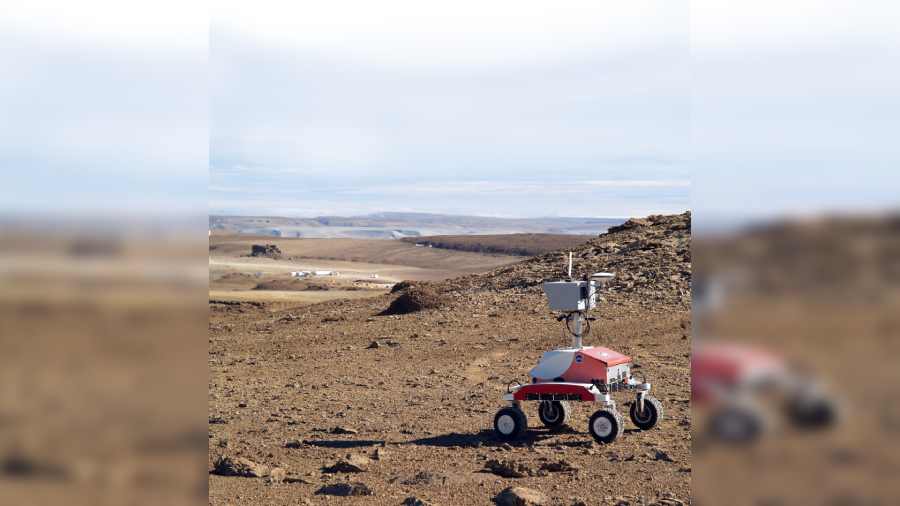In the historical imagination, astronomers look through telescopes, and photonic wisdom pours in at the speed of light. Taking what they can get, they passively receive information about far-off stars and planets. These objects are fixed, and their conditions cannot be tweaked.
“Throughout science, we reason by comparison all the time,” said Pascal Lee of the Mars and SETI institutes, US. “And so there’s something very fundamental to the approach of using analogues.”
“It actually makes a lot of sense why planetary scientists, whose phenomena are removed in time and space, would think that simulation and replication would be how they could still study that which is remote,” said Lisa Messeri, an anthropologist at Yale University, US, and author of the book Placing Outer Space, “because that’s what science has been doing for hundreds of years.”
The most direct arrow between this world and those beyond is the “terrestrial analogue”, a physical location on Earth that resembles some aspect of another world — usually the moon or Mars. That relevance can take the form of geological formations, such as lava tubes or sand dunes, or it can be a whole region with lunar or Martian flair, such as the Atacama Desert in Chile or volcanoes in Hawaii.
Lee runs the Haughton-Mars Project, an analog research station on Devon Island, an uninhabited, barren Arctic outpost in Nunavut, Canada.
The island is permacold and dry, with valleys and canyons, and boasts a 14-mile-wide crater left from a cosmic impact.
During dozens of field campaigns, the Haughton research station has provided a permanent place where scientists can pretend to be on the moon or Mars, study similar geology, test equipment for future missions and train humans to take part.
There are times, though, when scientists don’t need to go to an analogue: they can bring it home in the form of simulants, or material that resembles the surface of the moon or Mars.
Mars, for instance, is covered in sand and dust that together are called regolith. It makes travel difficult and can also block solar panels, clog filters and seize up moving parts. To determine how robotic rovers, power sources and other hardware will withstand those red-planet rigours, scientists have to test them against something similar before they make the journey.
That’s why, in 1997, Nasa developed a dusty substance called JSC-Mars 1, based on data from the Viking and Pathfinder missions. It is made from material found on the Pu’u Nene cinder cone volcano in Hawaii. There, lava once oozed into water, eventually forming regolithesque particles.
Nasa scientists improved on the material, while preparing the Mars Phoenix lander, and concocted Mars Mojave Simulant. It is sourced from the deposits of the Saddleback volcanic formation in Mojave Desert, California, US.
Today, private companies use Nasa’s data and recipes for private simulant supplies. This “add to cart” version goes into science-fair projects, alien cement and otherworldly gardening soil. Mark Cusimano, founder of one such company, The Martian Garden, said cultivating a red planet victory garden using Saddleback’s soil was his hobby. It’s satisfying, he said, to grow “a weird little radish or carrot in it.”
Today, researchers including Tom Runcevski of Southern Methodist University in Dallas, US, are looking at a different place: Titan, a moon of Saturn, the only world in the solar system other than Earth that has standing bodies of liquid on its surface.
“I always personally go talking about how hostile and terrifying Titan is,” Runcevski said. Lakes and seas swim with ethane. It snows benzene and rains methane. But if you look up through the haze, you’ll see the rings of Saturn.
Although a European space probe, Huygens, parachuted to its surface in 2005, Titan’s magnificent hostility is, in its totality, hard to understand from a hospitable planet such as this one.
But Runcevski is trying, having created in his lab what he calls “Titan in a Jar”.
You won’t see Saturn’s rings from the bottom of Runcevski’s jars. But you will learn about the organic compounds and crystals occupying its most famous moon. Inside the jars — test tubes, truthfully — Runcevski will put a drop or two of water, and then freeze it to mimic a tiny version of Titan’s core. He’ll add to that a couple of drops of ethane, which will condense straightaway, making mini moon-lakes. After that, he’ll add in other organic compounds of interest, such as acetonitrile or benzene. Then, he’ll suck the air out and set the temperature to Titan’s, around minus 292 degrees Fahrenheit.
Nasa is planning a return to Titan, launching a nuclear-powered quadcopter called Dragonfly in 2027. By watching the crystals and structures that form in his jars, Runcevski hopes to help scientists interpret what they see when the robotic explorer arrives in 2034.
NYTNS











